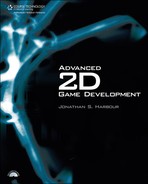Math Class Implementation
Now we can go over the code for the Math implementation file. The Math class includes the angular velocity and angle to target functions, which I will explain in detail in subsequent sections of the chapter.
#include "Advanced2D.h"
namespace Advanced2D {
double Math::toDegrees(double radians)
{
return radians * PI_under_180;
}
double Math::toRadians(double degrees)
{
return degrees * PI_over_180;
}
double Math::wrapAngleDegs(double degs)
{
double result = fmod(degs, 360.0);
if (result < 0) result + = 360.0f;
return result;
}
double Math::wrapAngleRads(double rads)
{
double result = fmod(rads, PI * 2.0);
if (result < 0) result + = PI * 2.0;
return result;
}
double Math::LinearVelocityX(double angle)
{
angle -= 90;
if (angle < 0) angle = 360 + angle;
return cos( angle * PI_over_180);
}
double Math::LinearVelocityY(double angle)
{
angle -= 90;
if (angle < 0) angle = 360 + angle;
return sin( angle * PI_over_180);
}
Vector3 Math::LinearVelocity(double angle)
{
double vx = LinearVelocityX(angle);
double vy = LinearVelocityY(angle);
return Vector3(vx,vy,0.0f);
}
double Math::AngleToTarget(double x1,double y1,double x2,double y2)
{
double deltaX = (x2-x1);
double deltaY = (y2-y1);
return atan2(deltaY,deltaX);
}
double Math::AngleToTarget(Vector3& source,Vector3& target)
{
return AngleToTarget(source.getX(),source.getY(),target.getX(),
target.getY());
}
double Math::Distance( double x1,double y1,double x2,double y2 )
{
double deltaX = (x2-x1);
double deltaY = (y2-y1);
return sqrt(deltaX*deltaX + deltaY*deltaY);
}
double Math::Distance( Vector3& vec1, Vector3& vec2 )
{
return Distance(vec1.getX(),vec1.getY(),vec2.getX(),vec2.getY());
}
double Math::Length(double x,double y,double z)
{
return sqrt(x*x + y*y + z*z);
}
double Math::Length(Vector3& vec)
{
return Length(vec.getX(),vec.getY(),vec.getZ());
}
double Math::DotProduct(double x1,double y1,double z1,
double x2,double y2,double z2)
{
return (x1*x2 + y1*y2 + z1*z2);
}
double Math::DotProduct( Vector3& vec1, Vector3& vec2 )
{
return DotProduct(vec1.getX(),vec1.getY(),vec1.getZ(),
vec2.getX(),vec2.getY(),vec2.getZ());
}
Vector3 Math::CrossProduct( double x1,double y1,double z1,
double x2,double y2,double z2)
{
double nx = (y1*z2)-(z1*y2);
double ny = (z1*y2)-(x1*z2);
double nz = (x1*y2)-(y1*x2);
return Vector3(nx,ny,nz);
}
Vector3 Math::CrossProduct( Vector3& vec1, Vector3& vec2 )
{
return CrossProduct(vec1.getX(),vec1.getY(),vec1.getZ(),
vec2.getX(),vec2.getY(),vec2.getZ());
}
Vector3 Math::Normal(double x,double y,double z)
{
double length = Length(x,y,z);
if (length != 0) length = 1 / length;
double nx = x*length;
double ny = y*length;
double nz = z*length;
return Vector3(nx,ny,nz);
}
Vector3 Math::Normal(Vector3& vec)
{
return Normal(vec.getX(),vec.getY(),vec.getZ());
}
};Now that you have the Math class available, you can begin exploring its features in a more convenient way (as opposed to writing examples with C++ functions, and then porting them to the class afterward—you can now just defer to the class directly).
..................Content has been hidden....................
You can't read the all page of ebook, please click here login for view all page.
